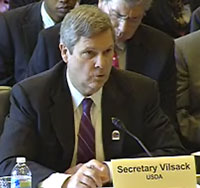The dairy economy was a topic of discussion during a full House Agriculture Committee hearing Thursday where Secretary of Agriculture Tom Vilsack testified about the outlook for the farm economy.
 “The livestock and dairy industries could face some financial pressures in 2011 and bear watching,” Vilsack told the committee. Getting more specific in his written testimony, Vilsack noted that dairy receipts are forecast to increase in 2011, but remain below 2007 and 2008 levels.
“The livestock and dairy industries could face some financial pressures in 2011 and bear watching,” Vilsack told the committee. Getting more specific in his written testimony, Vilsack noted that dairy receipts are forecast to increase in 2011, but remain below 2007 and 2008 levels.
While livestock prices are expected to remain strong and further improvement in milk prices is likely in the months ahead, higher feed costs could lead to below average margins for livestock and dairy producers in 2011. Milk production is estimated to increase by 1.8 percent in 2011 to 196.1 billion pounds. While feed costs are up considerably in recent months, a decline in cow numbers may not occur until later this year because of the large number of replacement heifers available. Milk per cow is forecast to increase again this year but at less than the pace for 2010. The gain in output per cow last year was due to good weather in addition to moderate feed prices. In recent weeks, both the domestic and international markets for dairy products have tightened considerably leading to a sharp increase in wholesale dairy product prices and futures prices for milk. Milk output has been affected by cold weather in the U.S. and Europe and heavy rains in New Zealand and Australia. Since early January, the wholesale prices of cheddar cheese, butter and nonfat dry milk have increased by 25-50 percent. The all-milk price is forecast to average $17.70-$18.40 per cwt. this year, compared with $16.29 in 2010 and $12.93 in 2009. While milk prices are forecast to be higher in 2011, increasing feed costs could continue to put financial pressure on dairy producers, especially those producers that purchase feed at current price levels.
Vilsack was asked specifically when USDA’s Dairy Industry Advisory Committee, which has been meeting for over a year, would be releasing a report. “We anticipate a report the first week of March,” Vilsack said. “They have finished their meetings and they are in the process of finalizing the draft of the report.”
Vilsack says there is a good deal of agreement, although not unanimous consensus, within the committee which was charged with trying to determine how best to address the issue of volatility in dairy markets.
